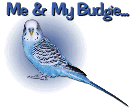

Whether you're getting your new budgie from a small pet shop, private breeder, big pet store chain, or anywhere else, it is important to be informed before buying. And it is important to keep in mind that even though the budgie itself may not be very expensive, feeding, housing, and caring for a budgie is a continual cost which includes cages, food costs, veterinarian visits and bills, toys, and time.
- Don't buy a budgie on impulse. Before buying a budgie, do some research. Visit the library or a book store and pick up some books and magazines about budgies and their care. Do searches on the Internet for budgies, and talk to other budgie owners.
- Choose a store or breeder that has a good environment for their budgies. This includes a clean cage and play area, plenty of toys, fresh water, fresh foods, and well trained employees. Buying any bird from a place that has bad conditions, unhealthy birds, and untrained employees only rewards those business and reaffirms them to continue their bad practices. It is important to avoid "pity purchases" from such places.
- Make sure that your budgie purchases come with a written guarantee of health where you have the option of returning the budgie if any health problem is discovered by your veterinarian.
- Choose a bird with a clean vent area. A dirty vent can be an indication of bad hygiene, digestive problems, or some other medical problem.
- Count the toes. A normal, healthy budgies should not be missing any toes. Also watch to see the bird perching, grasping, climbing, and basically making good use of its toes. If the toes show any abnormal scaliness this could also could be an indication of the existance of mites which is something to avoid.
- If you are shopping for a young budgie, look for the horizontal bars on the forehead of the bird. After the first molt, (at about 3 or 4 months) these bars will disappear.
- Look for clean, clear nostrils. Avoid buying a bird with caked on mucous on its beak or nostrils. This is a clear indication of a respiratory problem.
- Listen to the bird breathe. If you can hear 'clicking' sounds this may be a sign of air sac mites or other respiratory problems. A wheezing budgie is not a healthy budgie.
- Feathers and Wings: A healthy budgie should have complete wings. The wings may be clipped, but make sure that all the feathers are there. The feathers shoud be shiny and full.
- An alert and playful budgie is generally a better bet than the small, quiet budgie that sits alone in the corner. Alertness and activity is usually one sign of happy, healthy budgie.
- Look for a bird that is a good weight. Overweight budgies often show an obvious indented 'line' down the breast where the keel bone is. The fattier tissues are pushing beyond the keel. In an underweight budgie, the keel bone sticks out from the rest of the body tissue and is often a sign of a digestive problem or other health issues.
- Check the beak. The beak should meet cleanly, be relatively smooth, and not overgrown. An overgrown beak is often a sign of mites, or other more serious problems.
- Look for a budgie with good socialization skills. A socially happy budgie will be playful with other budgies and even humans if someone has taken the time to tame them.





